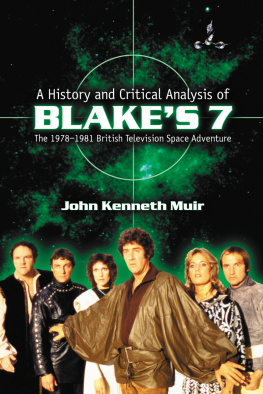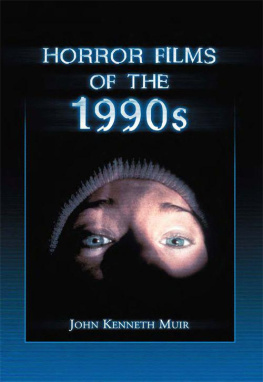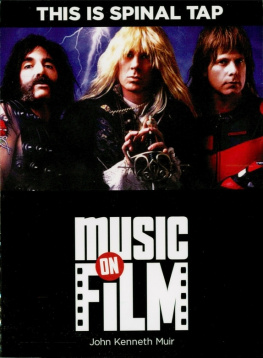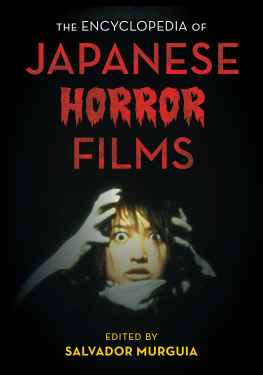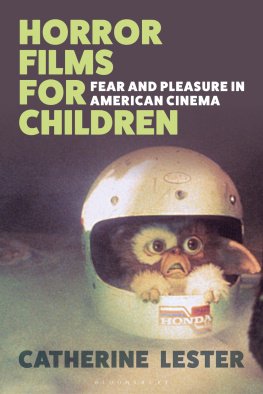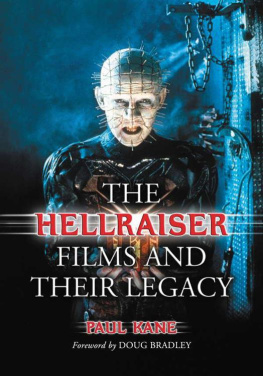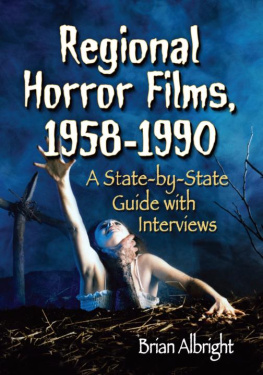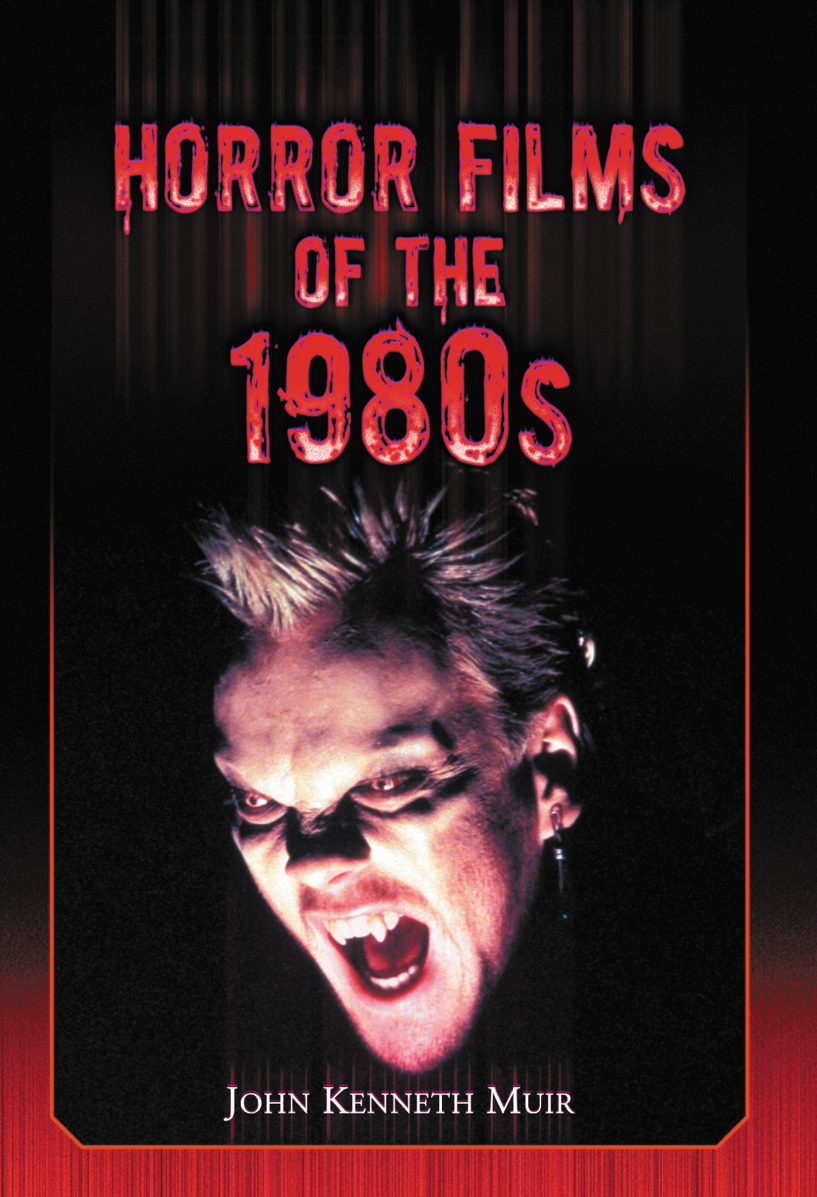Horror Films of the 1980s
Also by John Kenneth Muir and from McFarland
Horror Films of the 1990s (2011)
The Encyclopedia of Superheroes on Film and Television , 2d ed. (2008)
Eaten Alive at a Chainsaw Massacre:The Films of Tobe Hooper (2002; paperback 2009)
Horror Films of the 1970s (2002; paperback 2008)
An Analytical Guide to Televisions One Step Beyond , 19591961 (2001; paperback 2006)
Terror Television: American Series, 19701999 (2001; paperback 2008)
The Films of John Carpenter (2000; paperback 2005)
A History and Critical Analysis of Blakes 7 ,the 19781981 British Television Space Adventure (2000; paperback 2006)
An Analytical Guide to Televisions Battlestar Galactica (1999; paperback 2005)
A Critical History of Doctor Who on Television (1999; paperback 2008)
Wes Craven: The Art of Horror (1998; paperback 2004)
Exploring Space: 1999 : An Episode Guide and Complete History of the Mid-1970s Science Fiction Television Series (1997; paperback 2005)
Horror Films of the 1980s
John Kenneth Muir

McFarland & Company, Inc., Publishers
Jefferson, North Carolina
Library of Congress Cataloguing-in-Publication Data
Muir, John Kenneth, 1969
Horror lms of the 1980s / John Kenneth Muir.
p. cm.
Includes bibliographical references and index.
ISBN 978-0-7864-7298-7
softcover : acid free paper
1. Horror lmsUnited StatesHistory and criticism.
I. Title.
PN1995.9.H6M86 2012 791.436164097309048dc22 2006039752
British Library cataloguing data are available
2007 John Kenneth Muir. All rights reserved
No part of this book may be reproduced or transmitted in any form or by any means, electronic or mechanical, including photocopying or recording, or by any information storage and retrieval system,without permission in writing from the publisher.
On the cover: Kiefer Sutherland as the vampire David in the 1987 lm The Lost Boys (Warner Brothers/Photofest)
Manufactured in the United States of America
McFarland & Company, Inc., Publishers
Box 611, Jefferson, North Carolina 28640
www.mcfarlandpub.com
For my patient wife Kathryn. Thank you for making it through The Stay Awake.
Table of Contents
Preface
To paraphrase an ad line from a popular 1980s zombie ick, Im back from the grave and ready to party. My earlier horror lm survey from McFarland, Horror Films of the 1970s , earned a number of kudos (including a Booklist Editors Selection) when it was released in 2002, but psychologically, the 672 page tome took a lot out of me, which is why I wrote the happier Encyclopedia of Superheroes on Film and Television (2004) before broaching this text, which I knew would be in every way possible bigger and more elaborate than the disco decade edition.
More than 325 horror lms are surveyed and detailed in Horror Films of the 1980s . Unlike the popular and useful Internet Movie Database, however, the lms included herein are dated by the year of their American release , not the production or copyright year, which in some cases is different. In other words, Tremors was produced in 1989 but released in 1990, so it is not featured in this book. Instead it will be catalogued in Horror Films of the 1990s (keep watching the bookstores).
Why go about a survey in this fashion? As moviegoers with long personal histories, we tend to think immediately of the year and season a lm arrived in multiplexes to thrill us. It would seem just plain wrong to include two hits from the memorable summer of 1986 The Fly and Aliens in the year 1985. That doesnt jibe with memory. Similarly, the summer of 1982 was a golden age that included John Carpenters The Thing and Tobe Hoopers Poltergeist and it would be strange and disconcerting to think of them arranged instead in 1981 rather than 1982 when they were seen and reviewed.
This book covers all horror lms released from the year 1980 through the year 1989. There may be some debate about whether some of the lms included in the text are actually horror or science ction. Brainstorm (1983), Dreamscape (1984), The Terminator (1984) and Aliens (1986) leap to mind. For the purposes of this book, this is the judgment Ive made: If it is the movies aim to terrify, horrify or frighten, it qualies as a horror production. If the lms purpose is to illuminate with wonder or awe some aspect of a scientic discovery or future age, it is science ction and thus not included.
Representative lms from Italy, Canada, New Zealand, Japan and other countries are sprinkled throughout this text, too, especially if they had impact on American shores, emerging as video cult hits or even welcoming a foreign director into the brotherhood of American lmmaking. However, please note the following disclaimer: They are included under the names by which they rst came to America, even though those versions are often corrupted by retitling, dubbing or excessive cuts to satisfy the MPAA. Again, this is how these ventures were introduced to the country in the critical years of 1980 to 1989, and it seems appropriate to record them for posterity in that fashion.
All the lms reviewed in Horror Films of the 1980s appear alphabetically by year of American release, and entries follow a specic formula pioneered by Horror Films of the 1970s , so that these two books may be viewed as companion pieces.
As to specics: The Critical Reception for each entry is a sampling of reviews or blurbs. As the primary author, my view is important, of course, but other views should also be democratically represented, so the reader emerges with a fuller sense of how movies rate.
In that spirit, I have invited a number of guest reviewers to write short, original reviews for many lms. I did not assign particular lms to this cadre, because its more interesting to see how contemporary authors, critics and horror acionados select lms from the decade and then judge them. My guest reviewers in this books Critical Reception include the following talent (in alphabetical order):
Christopher Wayne Curry is the co-author of the 1998 Creation Cinema Book, A Taste of Blood: The Films of Herschell Gordon Lewis . Chris is here not just because he is a ne writer, but because he is an expert on fringe and underground cinema, and there is no shortage of that fare from the 1980s.
MaryAnn Johanson is the noted lm critic who writes as The Flick Filosopher and runs her own immensely popular review site (www.icklosopher.com). She also maintains a blog on Generation X issues, Geek Philosophy (www.geekphilosophy.com). MaryAnns specialty is Generation X geek culture and the reasons these 1980s lms have stuck in our collective memory for two decades. Her review choices in the book reect her interest in the thin line that blurs science ction and horror during the decade.
William Latham is the horror novelist behind Marys Monster , an updating of the Frankenstein mythos, as well as two Space: 1999 horror-oriented books published by Powys Media , Resurrection and Eternity Unbound . Bill also submitted his guest commentaries to Horror Films of the 1970s and my 2004 book, The Encyclopedia of Superheroes on Film and Television.
Joseph Maddrey is the author of the scholarly thesis from McFarland Nightmares in Red, White and Blue: The Evolution of the Modern American Horror Film , and here the author contributes a series of reviews that lean more towards the academic side of the critical spectrum. Joe is also the associate producer on the rst two seasons of the Discovery Channel paranormal TV series, A Haunting .


